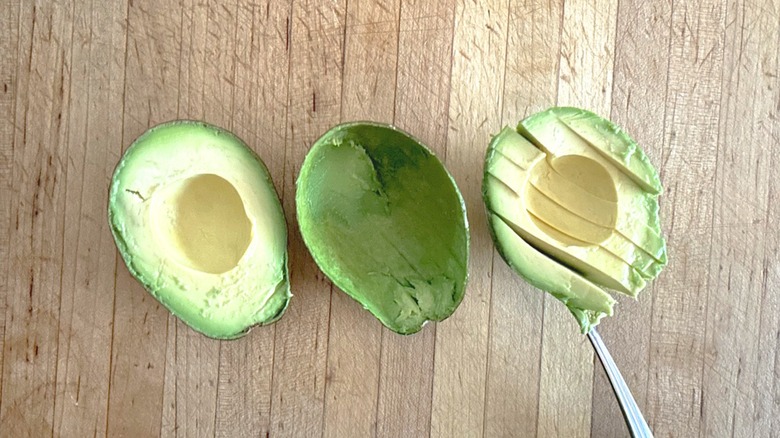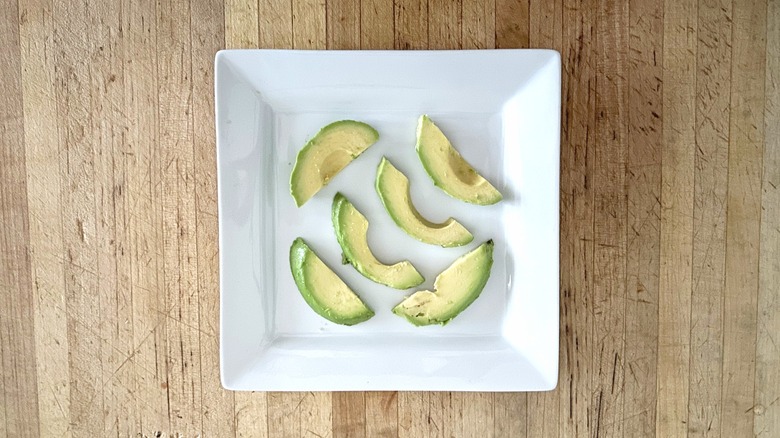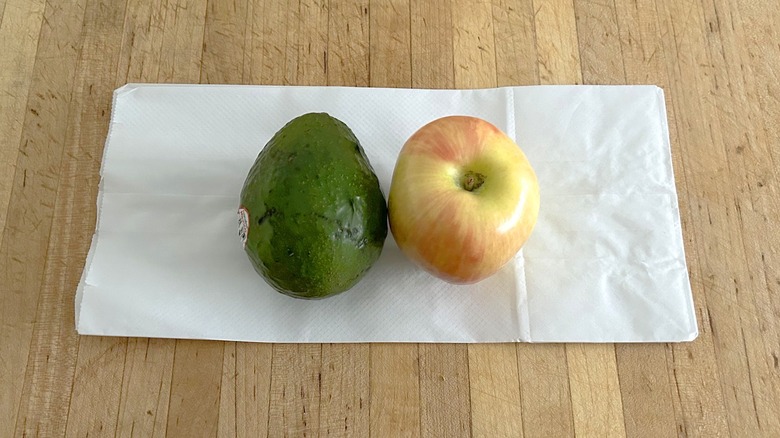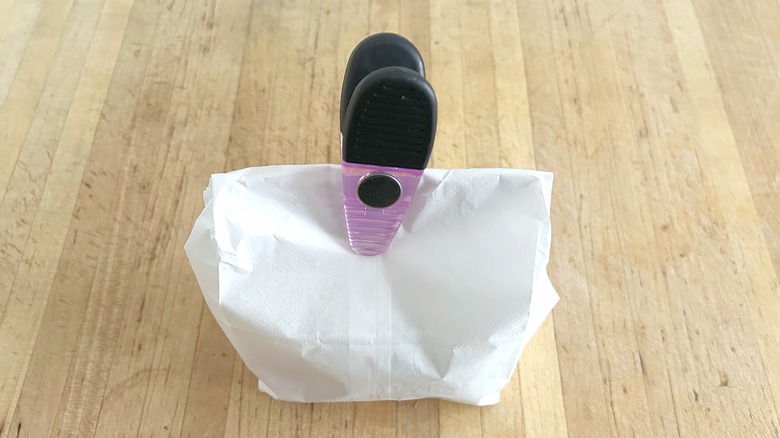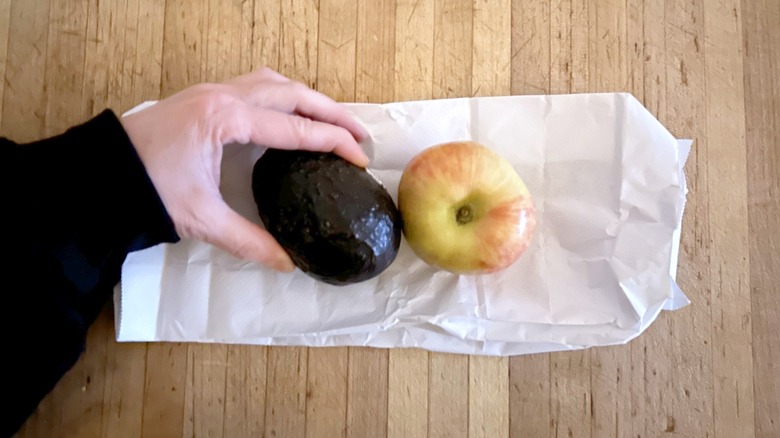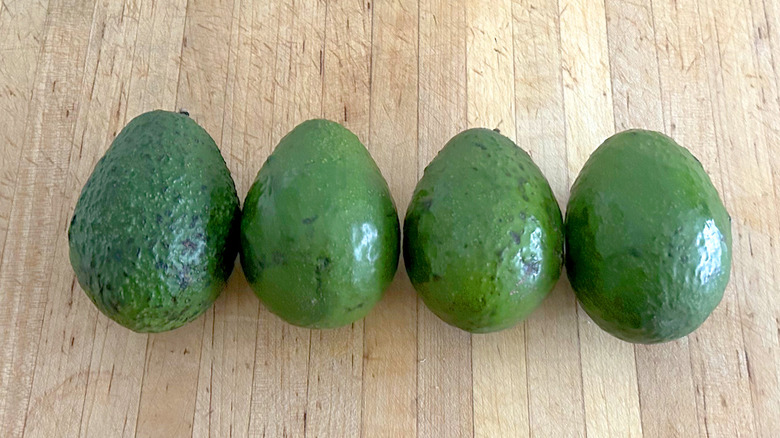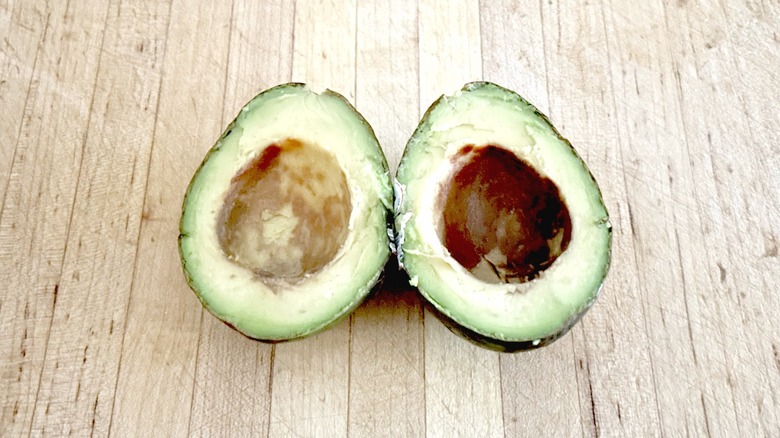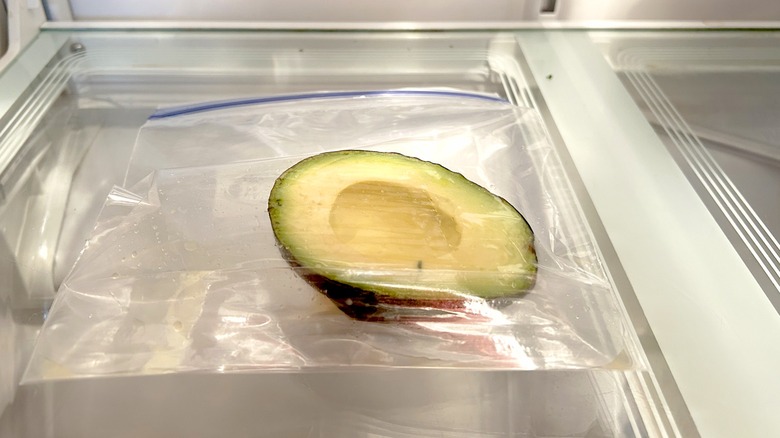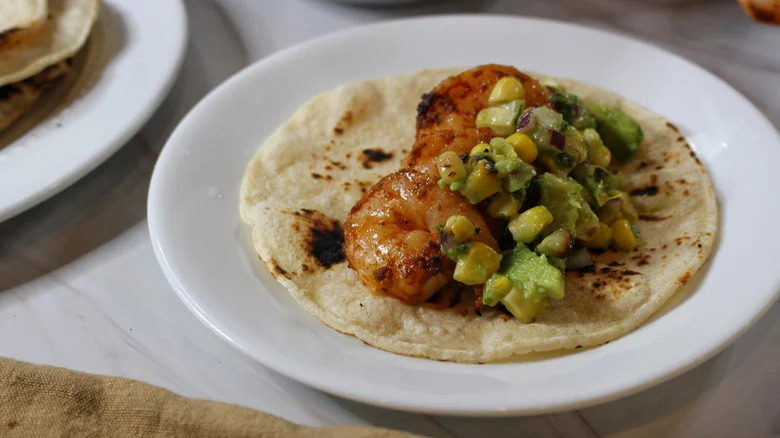How To Ripen An Avocado
It has happened to us all. You are getting ready to make a recipe using an avocado, like guacamole, and the only ones you can find at the local grocery store are hard, green hockey pucks. This is not an uncommon occurrence and is a by-product of the inherent nature of the avocado, making it delicious and capable of being transported thousands of miles from harvest to your plate, if not somewhat inconvenient.
Avocados are a fruit that emerged in south-central Mexico between 7,000 and 5,000 B.C. It was likely first cultivated around 500 B.C. in Mexico. This single-seeded berry, related to sassafras, bay laurel, and some cinnamon trees, is considered a climacteric fruit. Climacteric fruits are those that can ripen after being harvested. These fruits produce high quantities of ethylene gas, a naturally occurring hydrocarbon in plants. Ethylene gas thrives in warmer temperatures and under circumstances where airflow is restricted.
For us avocado lovers, what this means is that these fruits are harvested before they have naturally ripened to make them more hardy during transport from farm to table. An unripe avocado can take days to ripen left to its own devices and requires some gentle coaxing to expedite the process. Let's look at how you can determine if an avocado is ripe, the best way to ripen one, and how to store it once it has reached its apex.
How to know if an avocado is ripe
There are some basic rules of thumb when selecting a ripe avocado. A ripe avocado will have skin that ranges in hue from dark green to almost black. It will also have a rough texture rather than a smooth one. Lastly, when squeezed, you should feel a bit of give. The avocado should not be unyielding, nor should it be squishy.
Other things to consider when hunting for a ripe avocado include observing the nub where the stem of the avocado was once attached. There should be no evidence of mold or rot. Next, your avocado should not have an off smell. This can be an indication that it has already begun to rot. Third, if you feel the pit of an avocado rattling inside the fruit, it is past its prime, even if the meat does not feel overly mushy.
Lastly, avocados should be stored at room temperature until they are ripe. When a grocer sells avocados stored in the cooler of the produce section, go elsewhere. These avocados can undergo an enzymatic process that will deteriorate the cell structure of the fruit and cause it to ripen unevenly, developing brown spots. Though these brown spots do not make an avocado unsafe to consume, they can impact the flavor of the avocado, making it slightly bitter.
What tools/ingredients you'll need to ripen an avocado
The only method that expedites the ripening process — but will still take a day or two, depending on how unripe your avocado is — involves placing it in a paper bag or newspaper along with a piece of fruit that is a prolific ethylene gas producer, like an apple or a banana.
The tools and ingredients required for this method are minimal. You will need an unripe avocado, an apple or banana, and a paper bag or sheet of newspaper. You can also use a chip clip or another kind of clasp to keep the bag sealed if you have one on hand.
Place the avocado and apple in a paper bag
Place the avocado and apple or banana inside the paper bag and seal the bag. Alternatively, wrap them in a sheet of newspaper.
Check to see if the avocado is ripe
Check the avocado after 24 hours. If it is not ripe, return the avocado to the bag or newspaper and leave it for another 24 hours.
Repeat until the avocado is ripe
Repeat this process until the avocado is ripe, which should take 24-48 hours, depending on the avocado. Once ripe, use the avocado immediately or place it in the refrigerator.
Can you ripen an avocado in the oven, microwave, or by placing it in a warm place?
Though there are myriad methods for fast-ripening an avocado involving heating it, these techniques do not successfully ripen your fruit. We tested each of these methods, including popping it in the microwave, baking it at a low temperature in the oven, and setting it atop the radiator. They each yielded the same result. The avocado was cooked and softened but remained unripe.
With the microwave, the meat of the avocado became almost slimy and saucy rather than creamy. This process also made the avocado smell unpleasant. The avocados that spent time in the oven and atop the radiator never softened throughout, even though the peel was blackened. Though you could cut the meat with a knife, it did not yield fully and remained grainy. The flavor of all three was acrid, leaving an unpalatable aftertaste in your mouth that would never suffice in a recipe, even if the texture was passable.
How do you store an avocado and how long will it last?
Whole unripe avocados can last on the countertop for up to a week. Once an avocado is ripe, refrigerate it to halt the ripening process for up to three days. After cutting into an avocado, you should always store it in the refrigerator in an airtight container or secured in plastic wrap to prevent oxidation from turning the flesh brown. Coating the cut side of the avocado with oil or lemon juice to form a protective film between the meat and the air before wrapping it in plastic or placing it in an airtight container will further prevent oxidation. A cut avocado will last for up to a day in the refrigerator.
Avocados can also be frozen, though they will lose their verdant hue and become soft. To freeze an avocado, start by placing slices of the flesh on a baking sheet lined with parchment paper. These slices should not crowd or lay atop each other. Allow the pieces to freeze thoroughly before transferring them to an airtight container or freezer bag. Frozen avocados will keep in the freezer for up to a month. Place the avocado toward the back of your freezer, where it can avoid abrupt changes in temperature causing freezer burn.
Lastly, if you cut into your avocado before it ripens, sprinkle the flesh with lemon or lime juice and reassemble the halves with the pit intact. Encase this in plastic wrap and refrigerate the avocado until it has ripened.
These avocado recipes are ripe for your kitchen
The complexity conferred by its slightly sweet, nutty flavor and luxurious, velvety texture makes an avocado delightful in recipes. Though there is nothing wrong with a classic guacamole, avocado can make its way into myriad other dishes with Mexican flair, like these grilled shrimp tacos with avocado-corn salsa. The smoky grilled corn, the acidity of the lime juice, and the heat from the seasoning on the shrimp are delicately tempered by the butteriness of the avocado.
Avocado is also commonly found paired with sushi, ceviche, and other raw applications for fish. This colorful salmon avocado poke bowl highlights how textural contrast between crunchy vegetables, delicate fish, and creamy avocado can be juxtaposed by intense, nuanced flavors that are simultaneously salty, spicy, and rich with umami elements.
And if you are looking for a way to take a basic 3-bean vegetarian chili from simple to spectacular, look no further than avocado as the ideal garnish. It isn't just an accent. It becomes an integral textural component and vessel to help amplify the richness of hearty beans, acidic tomatoes, and spicy chili peppers. However you slice, dice, or mash it, a ripe avocado is an ingredient unmatched in its transformative capacity that can catapult your culinary game into the stratosphere.
